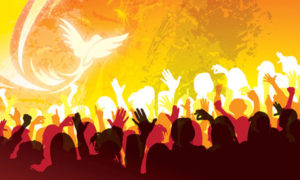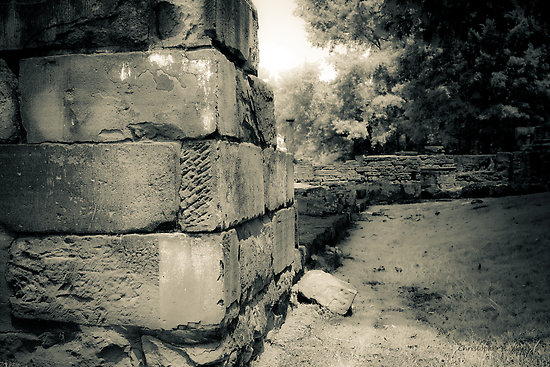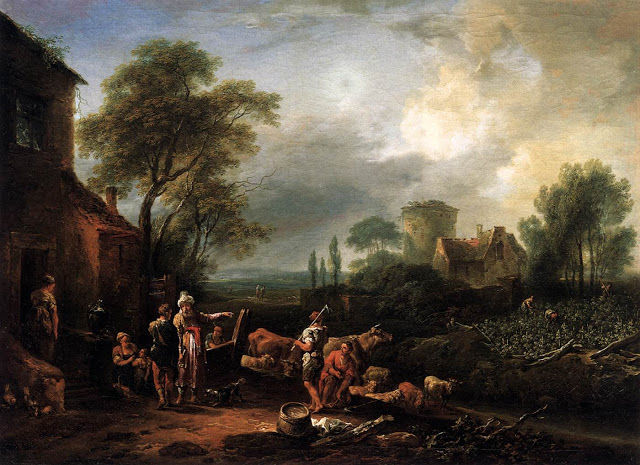JESUS AND THE FEAST OF PENTECOST
These seven Feasts represent and typify the sequence, timing, and significance of the major events of the Lord’s redemptive career. It is remarkable that there are seven in number of which seven stands for the completeness and perfection of the finished work of Jesus.
To properly understand the feast we are making use of typology. This will afford us the opportunity to draw out truth in seeing the connection of both covenants. Where the old Covenant stand as types and shadows which prefigure something in the New Covenant. They are listed in chronological order in Leviticus 23.
As we have seen, these feasts are a study in typology. The feasts of the Lord actually convey two forty year exodus periods, the type and the antitype. The first exodus period is when Israel was removed from bondage to Egypt at Passover, and they were put in the wilderness on a physical journey to a physical promised land. The antitype was a spiritual exodus fulfilled through the church.
This exodus period ran from the Cross to A.D. 70, a forty year period. In this exodus, the spiritual Israel, left the bondage under the Law of the sin and the death (Ro. 8:2) and begins a forty year spiritual journey to a spiritual inheritance; the Kingdom of God, also known as the New Heavens and New Earth.
In our previous series, we looked at the first three feasts, which were: Passover, Unleavened Bread, and First Fruits. We saw that Passover pictures the substitutionary DEATH of Jesus as the Passover Lamb. The Feast of Unleavened Bread pictures the DELIVERANCE from bondage. FIRST FRUITS pictures the RESURRECTION of Jesus the Messiah.
The fourth feast our focus for this installment is known in Hebrew as the feast of Shavuot, which means “weeks.” It is found in our main text in Leviticus 23:15-22:
‘You shall also count for yourselves from the day after the sabbath, from the day when you brought in the sheaf of the wave offering; there shall be seven complete sabbaths. ‘You shall count fifty days to the day after the seventh sabbath; then you shall present a new grain offering to the LORD. ‘You shall bring in from your dwelling places two loaves of bread for a wave offering, made of two-tenths of an ephah; they shall be of a fine flour, baked with leaven as first fruits to the LORD. ‘Along with the bread you shall present seven one year old male lambs without defect, and a bull of the herd and two rams; they are to be a burnt offering to the LORD, with their grain offering and their drink offerings, an offering by fire of a soothing aroma to the LORD. ‘You shall also offer one male goat for a sin offering and two male lambs one year old for a sacrifice of peace offerings. ‘The priest shall then wave them with the bread of the first fruits for a wave offering with two lambs before the LORD; they are to be holy to the LORD for the priest. ‘On this same day you shall make a proclamation as well; you are to have a holy convocation. You shall do no laborious work. It is to be a perpetual statute in all your dwelling places throughout your generations. ‘When you reap the harvest of your land, moreover, you shall not reap to the very corners of your field nor gather the gleaning of your harvest; you are to leave them for the needy and the alien. I am the LORD your God.'” Leviticus 23:15-22 NASB
In this feast God instructed Israel to count seven weeks from First Fruits and then the day after, this fourth feast was to be observed:
Seven weeks are 49 days if you add one day “the day after,” and it brings the total to fifty days. This fourth feast was to occur precisely fifty days after First Fruits.
Scriptures lets us know that during these 50 days between the Resurrection and Shavuot, Jesus met with His disciples many times, and on the 40th day He acceded into heaven. He had told them to stay in Jerusalem and “…wait for what the Father had promised.”
for John baptized with water, but you will be baptized with the Holy Spirit not many days from now.” Acts 1:5 NASB
During the period between the Ascension and Pentecost didn’t do anything but the selection of the twelfth apostle as recorded by Luke’s gospel. It seems he was reconstituting Israel through the foundational Apostles. The number twelve is the perfect number to bring about the antitype of the earthly one. With the reconstituted foundation, a new Israel was ready for Pentecost.
This was the instruction on the feast.
“And you shall celebrate the Feast of Weeks, that is, the first fruits of the wheat harvest, and the Feast of Ingathering at the turn of the year. Exodus 34:22 NASB
Thus, Shavuot marked the BEGINNING of the SUMMER WHEAT HARVEST even as Israel’s earlier Feast of First Fruits marked the beginning of the SPRING BARLEY HARVEST.
The Talmud referred to this festival as Atzeret, meaning: “CONCLUSION.” They viewed Shavuot as the conclusion of the Passover season and of the seven-week spring harvest since there are no other major Jewish holy days until the autumn.
In the Greek language Shavuot was known as Pentecost, meaning: “fiftieth” since it was celebrated on the 50th day from the Feast of First Fruits.
According to Jewish calendar fifty days has the essence of Jubilee. Jubilee is a fifty year concept that has to do with releasing the captives.
‘You shall also count for yourselves from the day after the sabbath, from the day when you brought in the sheaf of the wave offering; there shall be seven complete sabbaths. Leviticus 23:15 NASB
Just like the feast of first fruits Pentecost has no date either.
History of the Feast of Shavuot
In the third month after the Israelites left Egypt enroute Canaan, they arrived in the Sinai desert and camped opposite Mount Sinai. Moses was then told by God to gather the Israelites together to receive the Law:
In the third month after the sons of Israel had gone out of the land of Egypt, on that very day they came into the wilderness of Sinai. 2 When they set out from Rephidim, they came to the wilderness of Sinai, and camped in the wilderness; and there Israel camped in front of the mountain. 3 And Moses went up to God, and the LORD called to him from the mountain, saying, “Thus you shall say to the house of Jacob and tell the sons of Israel: 4 ‘You yourselves have seen what I did to the Egyptians, and how I bore you on eagles’ wings, and brought you to Myself. 5 ‘Now then, if you will indeed obey My voice and keep My covenant, then you shall be My own possession among all the peoples, for all the earth is Mine; 6 and you shall be to Me a kingdom of priests and a holy nation. ‘These are the words that you shall speak to the sons of Israel.” Exodus 19:1-6 NASB
In verse 6 we see something that was echoed in the new testament writings by Peter:
But you are A CHOSEN RACE, A royal PRIESTHOOD, A HOLY NATION, A PEOPLE FOR God’s OWN POSSESSION, that you may proclaim the excellencies of Him who has called you out of darkness into His marvelous light; 1 Peter 2:9 NASB
This was God’s plan for Israel. They substituted the Abrahamic covenant and got a new one at the foot of the mountain.
Now back to Exodus encounter:
So Moses came and called the elders of the people, and set before them all these words which the LORD had commanded him. 8 And all the people answered together and said, “All that the LORD has spoken we will do!” And Moses brought back the words of the people to the LORD. Exodus 19:7-8
Now Mount Sinai was all in smoke because the LORD descended upon it in fire; and its smoke ascended like the smoke of a furnace, and the whole mountain quaked violently. 19 When the sound of the trumpet grew louder and louder, Moses spoke and God answered him with thunder. Exodus 19:18-19 NASB
Moses then went up alone on the mountain, and as he neared the top, a mighty voice announced the Ten Commandments (Exodus 19:20-25; 20:1-21). That day was the very first Shavuot, the first Pentecost.
If you do the calculations of the datings you will discover that the Law was given on the sixth day of the third month of the biblical religious calendar, which is the month of Sivan (Sive-in). That day is exactly 50 days after the crossing of the Red Sea.
Shavuot is called the season of the giving of the Torah in Hebrew, because this is the literal day that God revealed Himself to the people of Israel as they stood at the base of Mount Sinai. Shavuot at Mt. Sinai is sometimes considered the day on which Judaism was born. It was Israel’s marriage with Jehovah. Though it wasn’t a very pleasant ceremony when you consider all the darkness, blackness and tempest.
On Shavuot/Pentecost, the Israelites were instructed to wave two loaves of leavened bread. Leaven symbolizes influence. They were to take no leaven from Egypt, they were to break from the influence of Egypt. The leaven from Egypt was a type of mixture. But at Pentecost two loaves of leavened bread indicated that both houses of Israel who are to influence the world with the Word of God.
According to Rabbinic tradition during the counting of the Omer, Psalm 67 was recited daily because it is composed of exactly 49 Hebrew words which correspond to the 49 days of the Omer count. The Psalm was considered seasonally appropriate because of its harvest motif that it embodies necessary for that feast.
God be gracious to us and bless us, And cause His face to shine upon us– Selah. That Your way may be known on the earth, Your salvation among all nations. Let the peoples praise You, O God; Let all the peoples praise You. Let the nations be glad and sing for joy; For You will judge the peoples with uprightness And guide the nations on the earth. Selah. Let the peoples praise You, O God; Let all the peoples praise You. The earth has yielded its produce; God, our God, blesses us. God blesses us, That all the ends of the earth may fear Him. Psalms 67:1-7 NASB
So in the year our Lord was crucified they are reciting this Psalm each day as they come to Shavuot or Pentecost. They never knew it was finding fulfillment in their time.
So we see that in the book of Acts 2 a remarkable account that ended as a fulfillment of the type of what the Shavuot/Pentecost represents.
The New Covenant anti-type of Shavuot is–Pentecost
Interesting to note is that of the seven divinely appointed feasts that were given to Israel, THREE were decreed by Yahweh as “SOLEMN FEASTS.” It required the presence of Jews in the Holy City on those three major festivals which was in obedience to the Torah as God commanded Moses:
“Three times in a year all your males shall appear before the LORD your God in the place which He chooses, at the Feast of Unleavened Bread and at the Feast of Weeks and at the Feast of Booths, and they shall not appear before the LORD empty-handed. Deuteronomy 16:16 NASB
Tacitus, the Roman historian, commented of the Feast of Shavuot and wrote, “The Holy City, with a population then of about six hundred thousand, exploded into between two and three millions because of the pilgrims.” That is why we find this account in the book of Acts.
And when the day of Pentecost had come, they were all together in one place. 2 And suddenly there came from heaven a noise like a violent, rushing wind, and it filled the whole house where they were sitting. 3 And there appeared to them tongues as of fire distributing themselves, and they rested on each one of them. 4 And they were all filled with the Holy Spirit and began to speak with other tongues, as the Spirit was giving them utterance. Acts 2:1-4 NASB
On the very day that the Jews from around the world gathered in Jerusalem to reaffirm their commitment to the Mosaic covenant and still practicing the shadow, the Holy Spirit descended upon Israel to offer the promise of the New Covenant to all who will believe. A New Covenant was officially unveiled.
And when the day of Pentecost had come, they were all together in one place. Acts 2:1 NASB
The release of the Spirit on Pentecost confirmed the new covenant. It was a change of order. The relevance of the temple has begun to shrink and decrease. The center of their worship will no longer be the old Temple, but the place of prayer and worship, the body of Christ through the Spirit wherever they may be.
And suddenly there came from heaven a noise like a violent, rushing wind, and it filled the whole house where they were sitting. Acts 2:2 NASB
What happened at Pentecost was outstanding. First, there was a loud sound, like the sound of a mighty, rushing wind, but only “like” it. There was no wind, just the sound. This perhaps “tornado-like” sound seems to be that which drew the large crowd to the place where the disciples were gathered. The pilgrims in Jerusalem heard something out of the ordinary. Contrary to what many have been taught, it wasn’t the sound of loud prayers that drew people’s attention.
Luke uses this particular word here to stress the life-giving breath of God, as symbolized by the wind. They were empowered with life to enter into the kingdom.
And suddenly there came from heaven a noise like a violent, rushing wind, and it filled the whole house where they were sitting. Acts 2:2 NASB
Notice that this wind filled the “House“. The question that is asked here is what house? In Luke’s writings the Temple is elsewhere referred to as “the House” (Luke 11:51):
“your (Jerusalem’s) House” (13:35)
In the Temple area, apart from the Holy Place and the court of the priests, there was a courtyard for the men of Israel, a further courtyard which women also could enter, and an outer court for Gentiles. Each courtyard was surrounded by walls in which were large porticoes where people regularly met for prayer. There were thirty spacious rooms around the Temple Court, described by Josephus and called oikoi, houses. Later these became a general meeting place for disciples (Acts 3:1, 10-11; 5:12).
Their presence at this time in the Temple would explain how the crowd gathered so quickly and could witness the “sound” (2:6), and how such a large group of disciples could be together (120).
And there appeared to them tongues as of fire distributing themselves, and they rested on each one of them. Acts 2:3 NASB
What is the significance of these tongues of fire? Throughout the Scriptures, fire is always a sign of God’s presence among His people. Recall that God spoke to Moses out of a burning bush.
God regularly revealed His presence by “fire.” He did it to Abraham (Genesis 15:17); when God led the people of Israel out of Egypt, there was a pillar of fire that went before them.
The presence of God was signified by fire at Sinai (Exodus 19:18; 24:17) and at the Tabernacle (Exodus 40:38), and Moses could say that God “spoke out of fire on the mountain” (Deuteronomy 4:11) at the giving of the covenant, so that they saw no likeness of God, only heard His voice. Moses stated, “Our God is a consuming fire” (Deut. 4:24). Similarly in Ezekiel 1:27; 8:2 God reveals Himself in “the likeness of the appearance of fire”. This would suggest that the fire is here a symbol of the presence of God.
God had changed the order. The manifestation of the flaming presence of God is no longer positioned over a tent or ark. This time it is over PEOPLE. Why? Because they are the new tabernacle and the temple of God. God is descending in fire on the new temple of His people by His Spirit.
By this they were enabled to speak in other tongues as the Spirit gave them utterance. This is Peter rose in defense when the Jews considered them drunk:
“For these men are not drunk, as you suppose, for it is only the third hour of the day; Acts 2:15 NASB
The third hour is nine o’clock in the morning. It is the time of the morning sacrifice that the Holy Spirit is being poured out:
And they were all filled with the Holy Spirit and began to speak with other tongues, as the Spirit was giving them utterance. Acts 2:4 NASB
The arrival of God by His Spirit in His permanent power and distinctive presence in His people was fulfilling the promise of the Spirit given to Israel. Pentecost is the fulfillment of that promise, and the Church—the true Israel.
Pentecost: Type and anti-type
Fifty four days after the first Passover in Egypt, the Law was given to the natural Israel at Mount Sinai, written upon tables of stone. In fulfilling the type fifty four days after the final Passover Jesus was sacrificed and the Spirit was given to the “Israel of God,”. A new law written in the hearts of believers.
“But this is the covenant which I will make with the house of Israel after those days,” declares the LORD, “I will put My law within them, and on their heart I will write it; and I will be their God, and they shall be My people. Jeremiah 31:33 NASB
On the first Shavuot/Pentecosr, the Law was given 3,000 people died for worshiping the golden calf, signifying the covenant of the Law that brought death but On the first New Covenant Shavuot/Pentecost Day, the Spirit was given 3,000 people received life and were added to the Church of Jesus the Christ (Acts 2:41), signifying the new covenant of the Spirit brought life:
who also made us adequate as servants of a new covenant, not of the letter, but of the Spirit; for the letter kills, but the Spirit gives life. 2 Corinthians 3:6 NASB
We see here that the New Covenant is LIFE, but the Old KILLS:
But if the ministry of death, in letters engraved on stones, came with glory, so that the sons of Israel could not look intently at the face of Moses because of the glory of his face, fading as it was, 2 Corinthians 3:7 NASB
On the first occasion, and 50 days after the Feast of First Fruits, God came down to Moses on Mt. Sinai to bring the Law. In the giving of the Law, God established the nation of Israel. As His covenant people, they were destined to become a people manifesting the righteousness of God. They would become a “royal priesthood and a holy nation.” Both the giving of the Law on Mt. Sinai and the giving of the New Covenant through the Holy Spirit to the 120 in the Temple were events that occurred on the very same day of the lunar calendar, the sixth of Sivan, the Day of Pentecost.
Pentecost was the fulfillment, the anti-type, of the type given to Israel. The giving of the Law at Mount Sinai involved the Aaronic priesthood, the sacrificial system, the Tabernacle, the Sabbath days, the festivals, the civil and ceremonial laws, and the Ten Commandments. All of them were to teach about Jesus:
Then I said, “Behold, I come; In the scroll of the book it is written of me; Psalms 40:7 NASB
The Tanakh known as the law was pointed men to Christ.
Now the promises were spoken to Abraham and to his seed. He does not say, “And to seeds,” as referring to many, but rather to one, “And to your seed,” that is, Christ. Galatians 3:16 NASB
All the promises that God made to Israel are fulfilled in Christ. All believers are in Christ and share all that Christ is and has. Jesus fulfilled Israel.
The feast is highly significant as it was also the undoing of what happened at Babel. Despite our language and cultural differences by the Spirit all have been brought in Christ.
Credits:
– Judaism 101
– Feast of Pentecost, David Curtis



